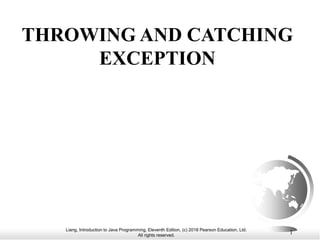The document discusses exception handling in Java. It covers topics like throwing and catching exceptions, checked vs unchecked exceptions, defining custom exception classes, and using assertions. The try-catch-finally block is used to catch exceptions. Exceptions can be thrown and caught within methods. Finally blocks are always executed even if an exception occurs.








































![Liang, Introduction to Java Programming, Eleventh Edition, (c) 2018 Pearson Education, Ltd.
All rights reserved.
41
Executing Assertions Example
public class AssertionDemo {
public static void main(String[] args) {
int i; int sum = 0;
for (i = 0; i < 10; i++) {
sum += i;
}
assert i == 10;
assert sum > 10 && sum < 5 * 10 : "sum is " + sum;
}
}
Companion
Website](https://image.slidesharecdn.com/12slide-230802090819-c4a2580d/85/unit-4-ppt-41-320.jpg)










![Liang, Introduction to Java Programming, Eleventh Edition, (c) 2018 Pearson Education, Ltd.
All rights reserved.
52
Writing Data Using PrintWriter
java.io.PrintWriter
+PrintWriter(filename: String)
+print(s: String): void
+print(c: char): void
+print(cArray: char[]): void
+print(i: int): void
+print(l: long): void
+print(f: float): void
+print(d: double): void
+print(b: boolean): void
Also contains the overloaded
println methods.
Also contains the overloaded
printf methods.
.
Creates a PrintWriter for the specified file.
Writes a string.
Writes a character.
Writes an array of character.
Writes an int value.
Writes a long value.
Writes a float value.
Writes a double value.
Writes a boolean value.
A println method acts like a print method; additionally it
prints a line separator. The line separator string is defined
by the system. It is rn on Windows and n on Unix.
The printf method was introduced in §4.6, “Formatting
Console Output and Strings.”
Run
WriteData](https://image.slidesharecdn.com/12slide-230802090819-c4a2580d/85/unit-4-ppt-52-320.jpg)







